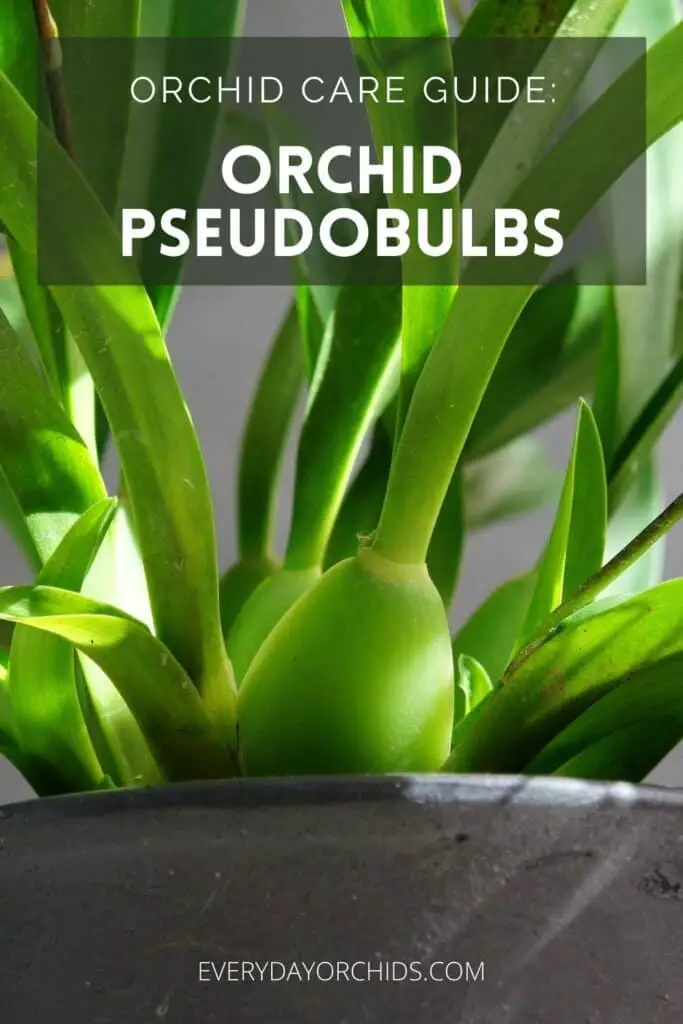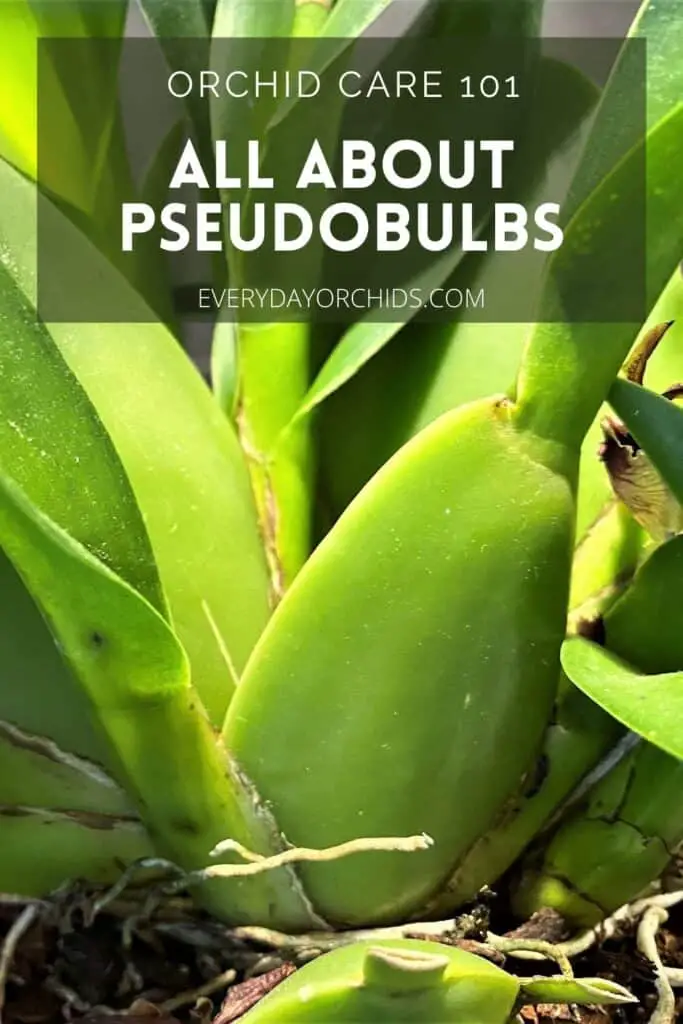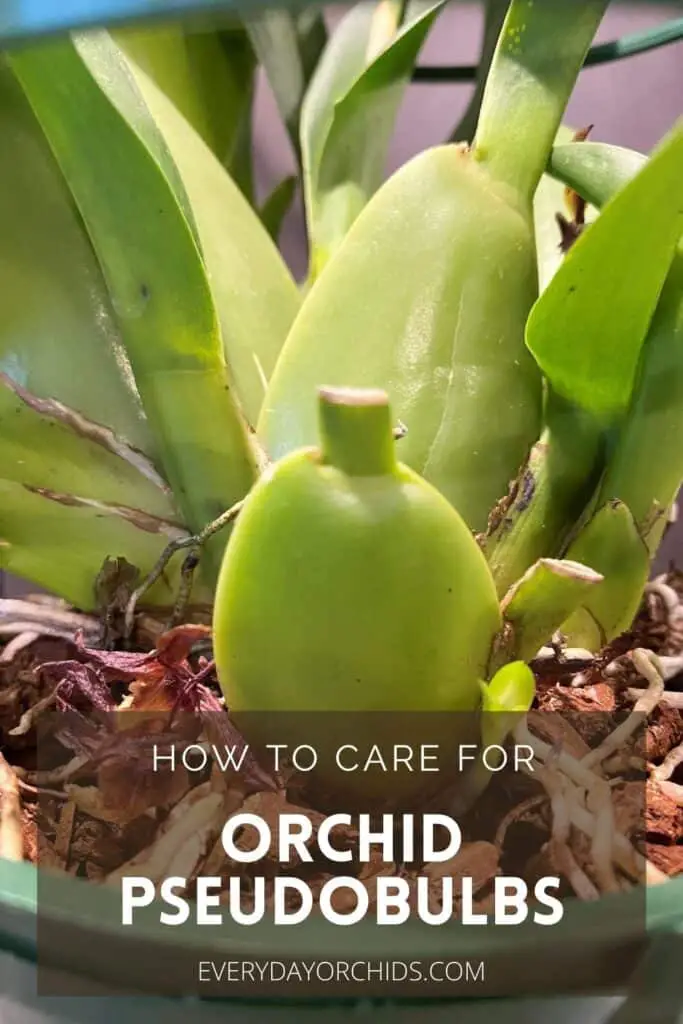Certain species of orchids, such as Oncidiums and Dendrobiums, have pseudobulbs, while others don’t. Have you ever wondered why this is the case? I’ll go over why in more detail below.
Pseudobulbs are actually an essential part of your orchid, so don’t ignore them. As part of your orchid care, you’ll want to inspect and ensure that your orchid’s pseudobulbs remain healthy. If the pseudobulb shows signs of distress, it is a sign that the rest of the orchid likely has problems too.
Orchid pseudobulbs serve as storage organs for water and nutrients. They help an orchid survive through dry seasons. In addition, new orchids can be propagated through pseudobulb division. Pseudobulbs can become wrinkled if the orchid is under-watered. They are also at risk for rot and infection. These issues will need to be addressed immediately.
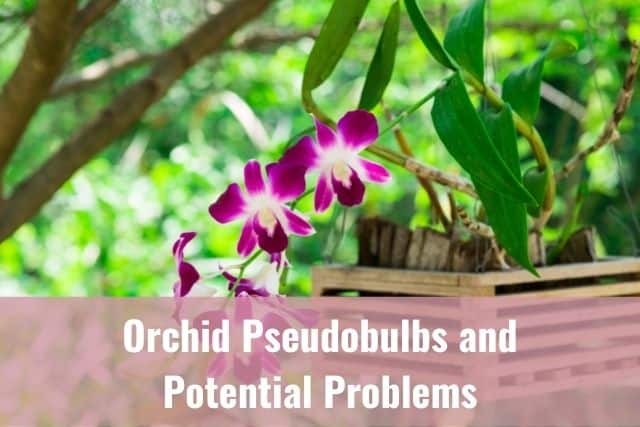
I’ll go over orchid pseudobulbs in more detail below, along with which orchids have pseudobulbs and what a healthy orchid pseudobulb looks like. You’ll learn how to propagate orchids via pseudobulb division. This is a fast and easy way to expand your orchid collection.
You’ll also learn about potential problems you may encounter related to the orchid’s pseudobulb and what to do about it. Pseudobulb problems are an indicator of a bigger problem in your orchid, so you’ll want to pay close attention to the health of your orchid’s pseudobulbs. Keep reading to learn more.
Please note that these links are affiliate links and as an Amazon Associate, I earn from qualifying purchases. Purchases made through affiliate links in this post may generate commissions at no additional cost to you. Use this link for a discounted Amazon Prime trial. Thank you for your support!
Table of Contents
What Are Orchid Pseudobulbs?
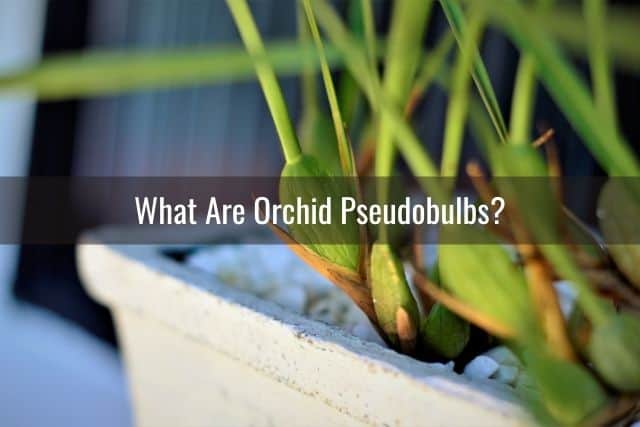
Pseudobulbs are above-ground storage organs that grow between the leaves of certain orchid species. They are generally found in epiphyte orchids.
Sympodial orchids, such as Cattleyas, Oncidiums, and Dendrobiums, have pseudobulbs. Monopodial orchids, such as Phalaenopsis orchids and Vanda orchids, don’t have pseudobulbs.
In sympodial orchids, pseudobulbs grow from a rhizome. This is a horizontal root-bearing stem growing just above or under the surface of the potting media.
Each pseudobulb will develop leaves and at times, a flower spike. As the rhizome grows and spreads out, it will send up more leafy shoots and pseudobulbs along its length.
In some orchids, such as Dendrobium and Epidendrum orchids, pseudobulbs are thickened cane-like stems. Leaves develop along the length of the pseudobulb cane. Keiki orchids can sprout from various nodes along the cane. This is a natural and easy way to propagate more orchids.
In other orchids, such as Oncidium, Cattleya, and Miltoniopsis orchids, pseudobulbs are bulb-shaped, smooth and fleshy. Oncidium orchids and Laelia orchids have leaves and flower spikes, or inflorescences, which develop from the top of these pseudobulbs.
Why Do Some Orchids Have Pseudobulbs And Other Orchids Don’t?
Pseudobulbs are an adaptation orchids have developed to survive periods of drought. Some orchids live in areas with distinct wet and dry seasons. Pseudobulbs help the orchid get through those dry seasons.
Catasetum orchids are one example of this. It will prepare for a long, dry season by storing water and nutrients in the pseudobulbs. Once the wet season returns, the orchid will experience rapid growth and develop more pseudobulbs in order to store more water for the next dry season.
Pseudobulbs can live anywhere from 1 to 5 years, depending on the orchid species.
What Is The Purpose Of An Orchid Pseudobulb?
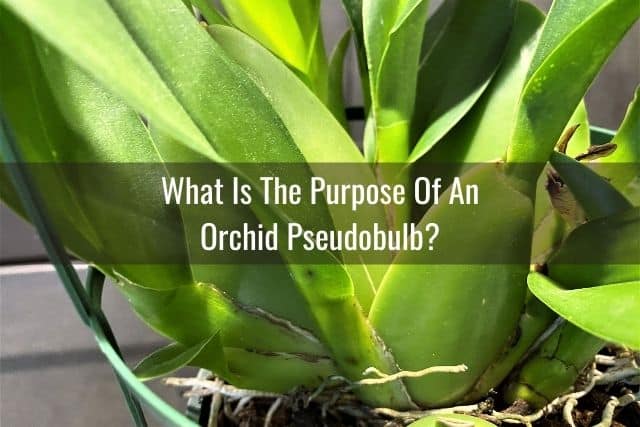
Storage
Pseudobulbs are used to store water and nutrients for orchids. They are an adaptive structure that allow the orchid to survive during periods of drought and reduced water. Think of pseudobulbs like the humps on a camel’s back.
During growth seasons and periods when water is in abundance, orchids will store water and nutrients in it’s pseudobulbs. During dry seasons or when it is developing new pseudobulbs, the orchid will draw upon the water and nutrients stored in the established pseudobulbs.
Propagation
Dividing pseudobulbs is an easy and low-cost method to propagate new orchids.
Here is a step-by-step method for propagating orchids via pseudobulb division:
- To do this, you’ll need a healthy orchid with at least six pseudobulbs.
- Unpot your orchid and rinse off the roots to remove any old potting media.
- Identify the rhizome, which is a long, horizontal root-bound stem. There will be pseudobulbs and growths sprouting off from this rhizome.
- Next, identify the older pseudobulbs, which will be called “back bulbs,” and new, younger pseudobulbs.
- Use a sterilized razor blade to divide the orchid into groups of three pseudobulbs each. Make sure that the first, leading pseudobulb in each cluster is starting to bud and show new growth.
- Pot each cluster of pseudobulbs into it’s own orchid pot using new orchid potting media.
- Position the leading pseudobulb towards the center of the pot, rather than the sides of the pot. This will ensure that the pseudobulb has lots of room to grow. You will see new growth sprouting within the next few weeks.
Propagation Tips For Success
It will take a while for the new growth to establish itself, so don’t expect the newly divided pseudobulbs to flower right away. In fact, it will likely be at least a year before you see your newly divided, propagated orchid start to flower.
In the mean time, the rhizome will continue to spread out across the pot. The orchid will hopefully also develop more pseudobulbs the following year.
Just make sure that the rhizome is not buried too deeply under the potting media. If it is, there is a higher chance it will rot. Depending on the orchid species, you can either cover the rhizome with a thin layer of potting media, or allow it to sit above the potting media.
Pseudobulb propagation works best in the early spring, right before the growth period for orchids starts. If you can divide your pseudobulbs at this time, you’ll have the best chances for success.
What Does A Healthy Pseudobulb Look Like?

A healthy pseudobulb will be green, smooth, and plump. It will be filled with water and nutrients for the orchid. It should not be limp, wrinkled, discolored, or have soft, mushy areas.
One exception to this is older pseudobulbs. Older pseudobulbs may be wrinkled while being perfectly healthy. I will go over this point in more detail below.
What If All The Leaves Fall Off The Pseudobulb?
This is a normal occurrence and not a cause for concern. There are times when all the orchid leaves may fall off the pseudobulb, for one reason or another.
As long as the pseudobulb itself still appears healthy, it is best for you to leave it on the orchid. It is still functioning as a storage organ for the orchid, even if it may not be supporting leaves or a flower spike. Do not cut it off or remove it unless the pseudobulb itself is diseased, rotted, or dead.
Older Pseudobulbs Are Becoming Wrinkled
As pseudobulbs age, they can start to get wrinkled. This is true even if you have done a great job with your watering practices and your orchid is healthy.
As new pseudobulbs develop and grow, they will draw water and nutrients from the older pseudobulbs, causing them to become wrinkled. In a sense, older pseudobulbs become feeder bulbs for newer growth. This can happen in particular with Oncidium orchids.
Wrinkling of older pseudobulbs is permanent. No amount of watering will reverse the wrinkling. In fact, I would discourage you from trying to save older pseudobulbs this way, as overwatering can quickly lead to rot.
As long as the rest of the orchid remains healthy and the older pseudobulb doesn’t show signs of shriveling, discoloration, or rot, I wouldn’t worry. Every pseudobulb has a specific life span. Older pseudobulbs will become more wrinkled with age, and this is perfectly normal.
Problems With Orchid Pseudobulbs
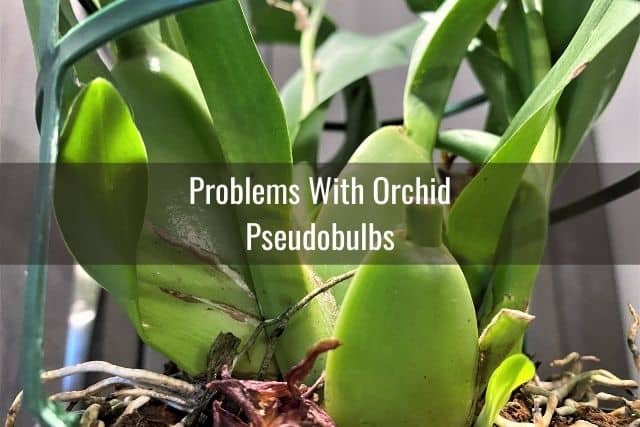
At times, you may come across a pseudobulb that is shriveled, or even worse, yellow or brown and mushy. Let’s go over some of the top problems you may see with orchid pseudobulbs.
Orchid Pseudobulbs Are Rotted
Orchids are very sensitive to how you water them, as well as how often. Excessive watering can lead to root rot in orchids, as well as rotted pseudobulbs.
Rotted pseudobulbs will be soft, brown, or mushy, or all of the above, depending on the severity of the rot.
In many cases, when the pseudobulb is rotted, it will have started to turn brown or black at the base. In addition, the brown or black discolored area will feel softer.
Cattleya orchids are particularly prone to pseudobulb rot, but this can happen to any sympodial orchid that has been overwatered.
If the pseudobulb is turning brown or black at the base, and getting soft and mushy at the base, it is likely due to rhizome rot.
In this case, the rot started at the rhizome and has now started to creep up and spread to the pseudobulb. Once you notice this, you have to act fast, as the rot can quickly spread along the rhizome to other pseudobulbs if left unchecked.
How To Deal With A Rotted Pseudobulb
When you find a rotted pseudobulb, chances are high that the underlying rhizome and roots are rotted as well. This is a good time to repot your orchid and remove the old potting media.
Cut off the rotted roots, rhizome and pseudobulbs using a sterilized pair of gardening shears. When cutting off the rotted tissue, be sure you cut off a thin portion of healthy tissue as well. This will ensure that you’ve removed all the rot.
Dab some ground cinnamon powder on the cut areas of the remaining orchid. If the rot is extensive, treat the entire orchid with a fungicide.
Repot your orchid using fresh orchid potting media. When you pot your orchid, point the newest growth towards the open area of the pot, so that it has room to grow and spread out.
Moving forward, pay closer attention to your watering practices and only water your orchid when the top few inches of the potting media is dry. Provide it with adequate humidity using a cool-mist humidifier.
For more information, check out these guides on how to water your orchid and how to repot your orchid.
Orchid Pseudobulbs Have Brown Or Black Marks
Sometimes, you may notice that your orchid’s pseudobulbs have brown or black splotches scattered across them. This is different than pseudobulb rot, because the brown or black discoloration is not limited to the base of the pseudobulb.
If you notice this, then observe your orchid to see if the discoloration grows in size or spreads. If it does, then you will need to use a sterilized razor blade to remove the infected pseudobulb. Discoloration that spreads or grows likely indicates a fungal infection leading to rot.
If the discoloration does not spread or grow, then the brown or black splotches are likely due to damage to the pseudobulb during the winter, when the weather is particularly cold.
It can also be due to trauma and bruising, which can happen if the orchid were dropped or bumped during transport. While the brown and black splotches are not aesthetically pleasing, as long as they remain stable, they do not pose a threat to your orchid’s health.
Pseudobulbs Are Wrinkled Due To Insufficient Watering Or Humidity
When an orchid doesn’t have enough water, it will start to draw from its storage organs for water and nutrition. As water is pulled from the pseudobulb, it will start to become wrinkled. If the orchid is still not watered adequately over time, the pseudobulb will become deeply wrinkled and limp.
Wrinkling of the pseudobulb is permanent. Even if you catch the wrinkling early on and begin watering your orchid regularly, trace wrinkles will remain on the pseudobulb.
If the orchid is very dehydrated, you may find that in addition to the pseudobulb being wrinkled and limp, it is also yellow.
In this case, it is likely that the pseudobulb is dying. You likely also have dehydrated orchid roots as well.
To save your orchid, water your orchid immediately and soak the roots for at least 15 minutes in luke-warm water.
You can also use an Epsom salt soak to rehydrate the orchid roots. Give it more attention but be careful not to overdo it and overwater your orchid.
For more information, read this guide on how to save an orchid with dried, shriveled roots.
In addition, make sure you are providing your orchid with sufficient humidity. Humidity is incredibly important for an orchid’s health and growth. You may need to supplement humidity levels using a humidifier or a humidity tray.
Pseudobulbs Are Wrinkled Or Shriveled Due To Insufficient Fertilization
Another reason why orchid pseudobulbs can become wrinkled is due to insufficient fertilization.
If an orchid is not fertilized regularly, it can cause the pseudobulbs to shrivel. Remember, the pseudobulb is a storage organ for both water and nutrition. Orchids require regular fertilization to support their growth.
To address this, read this guide on how to fertilize your orchid. Find out about the fertilization needs for your specific orchid. When you do fertilize your orchid, remember that orchids prefer weak fertilizer, meaning you will need to dilute the orchid fertilizer further.
When Should You Cut Off Pseudobulbs On Your Orchid?
There are a few cases in which you should remove your orchid’s pseudobulbs. Obvious indications would include rot or disease.
You can also remove dried up, dead pseudobulbs. Be careful with this though. Confirm that the pseudobulb is completely dried out and dead before you remove it.
Pseudobulbs that are wrinkled, but still firm are still alive and serving a purpose. Leave those pseudobulbs on your orchid. Your orchid can still use those wrinkled, but firm older pseudobulbs as storage organs. If the pseudobulb feels like a brittle dried out husk, however, then it is safe to remove.
If the pseudobulb is yellowed, wrinkled, and limp, it is likely beyond saving. Your main goal at this point should be to save the orchid. If you are able to salvage your orchid and nurse it back to health, it will grow new, healthy pseudobulbs in the future.
When the pseudobulb is completely dried and yellowed, you can remove it using a sharp, sterilized razor-blade, cutting it off close to the base of the orchid. Follow up with a dab of ground cinnamon powder on the cut end. This will help seal off the orchid and prevent infection.
Any time you remove a pseudobulb from your orchid, make sure you use a sterilized razor blade to cut off the dead or rotted tissue. This will allow you to make a precise, clean cut.
If you are removing a pseudobulb due to rot, it would be a good idea to follow up with a fungicide treatment to prevent the rot from spreading.
Final Thoughts
Orchid pseudobulbs are a unique adaptation that sympodial orchids have developed over time. These storage organs help the orchid deal with dry seasons and survive longer without regular watering. However, this doesn’t mean that you can neglect your orchid or water it less frequently.
If anything, pseudobulbs are another way that your orchid can communicate with you. Plump, wrinkle-free, firm pseudobulbs are a sign that your orchid is healthy and doing well. Anything else can indicate a problem that you will need to address.
If you enjoyed this article, please pin it and share!
